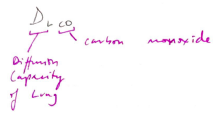F7iv: Define diffusing capacity & its measurement
Definition
- The rate of gas transfer/partial pressure difference for the gas
- Gases move along their partial pressure gradients (NOT concn gradients)
- This is how you measure the rate of diffusion of a gas because it’s not possible to determine ‘T’ thickness & ‘A’ SA of Fick’s Equation
Carbon Monoxide
- Moves rapidly across membrane
- Reacts with high affinity to Hb
- Partial Pressure hardly rises at all
- ∴gives a constant partial pressure gradient for diffusion
- ∴said to be DIFFUSION LIMITED → so it’s v. good to determine diffusing capacity!
Single Breath method to assess DLCO
- Subject exhales maximally
- Nose clamped & takes single vital capacity breath with mixture of 0.3% CO & 10% helium (He)
- Breath held for 10 secs (to overcome maldistribution of expired gas)
- He does NOT enter blood
- ∴Ratio of He Fi/FE x Volume drawn into alveoli will indicate total alveolar volume during breath holding
- VOL of CO UPTAKE measured by multiplying He FI/FE ratio x PCO of inspired gas
- Expired PCO is measured directly
- Exhaled gas is analysed for CO by infrared analysis
Values
- KCO = transfusion co-efficient of CO
- ↓KCO & ↓DLCO
- Emphysema
- Fibrosing alveolitis
- Pulmonary vascular disease
- KCO(N) & ↓DLCO: small lung volumes
- Pleural effusion
- Muscle weakness
- Consolidation
- ↑DLCO: hmrrg → because more blood available for reaction ∴over-estimated
- ↓DLCO: anaemia → underestimated because ↓[Hb]
